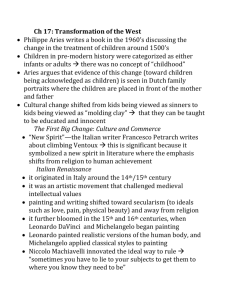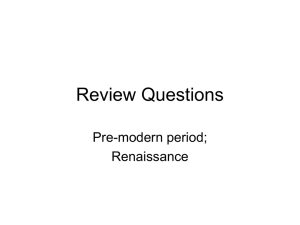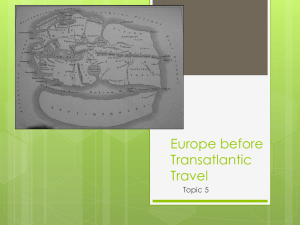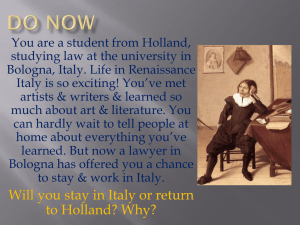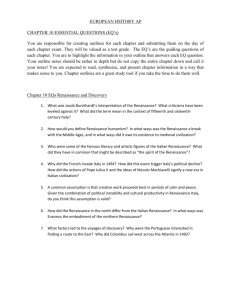AP European History, Exam-
advertisement
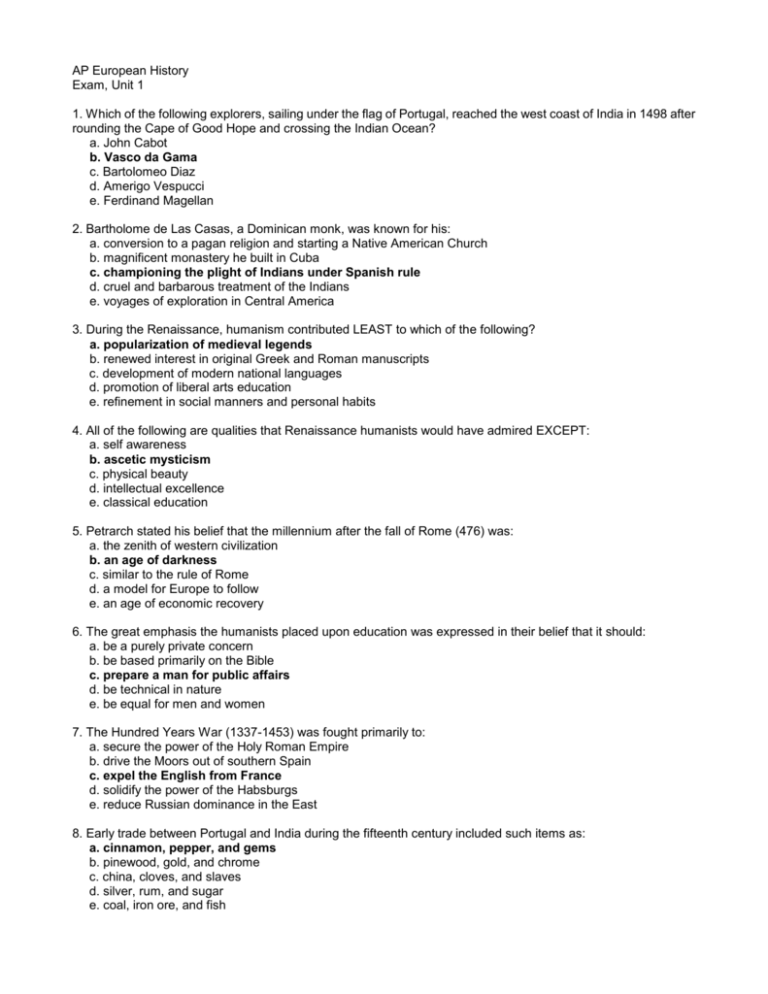
AP European History Exam, Unit 1 1. Which of the following explorers, sailing under the flag of Portugal, reached the west coast of India in 1498 after rounding the Cape of Good Hope and crossing the Indian Ocean? a. John Cabot b. Vasco da Gama c. Bartolomeo Diaz d. Amerigo Vespucci e. Ferdinand Magellan 2. Bartholome de Las Casas, a Dominican monk, was known for his: a. conversion to a pagan religion and starting a Native American Church b. magnificent monastery he built in Cuba c. championing the plight of Indians under Spanish rule d. cruel and barbarous treatment of the Indians e. voyages of exploration in Central America 3. During the Renaissance, humanism contributed LEAST to which of the following? a. popularization of medieval legends b. renewed interest in original Greek and Roman manuscripts c. development of modern national languages d. promotion of liberal arts education e. refinement in social manners and personal habits 4. All of the following are qualities that Renaissance humanists would have admired EXCEPT: a. self awareness b. ascetic mysticism c. physical beauty d. intellectual excellence e. classical education 5. Petrarch stated his belief that the millennium after the fall of Rome (476) was: a. the zenith of western civilization b. an age of darkness c. similar to the rule of Rome d. a model for Europe to follow e. an age of economic recovery 6. The great emphasis the humanists placed upon education was expressed in their belief that it should: a. be a purely private concern b. be based primarily on the Bible c. prepare a man for public affairs d. be technical in nature e. be equal for men and women 7. The Hundred Years War (1337-1453) was fought primarily to: a. secure the power of the Holy Roman Empire b. drive the Moors out of southern Spain c. expel the English from France d. solidify the power of the Habsburgs e. reduce Russian dominance in the East 8. Early trade between Portugal and India during the fifteenth century included such items as: a. cinnamon, pepper, and gems b. pinewood, gold, and chrome c. china, cloves, and slaves d. silver, rum, and sugar e. coal, iron ore, and fish 9. A sixteenth-century traveler would have been most likely to encounter this type of architecture in which of the following European countries? a. Spain b. France c. Germany d. England e. Sweden 10. Machiavelli's ideas as expressed in The Prince promoted: a. a modern secular approach to power politics b. a unified republican state in Italy c. little in the way of lasting influence d. a new attitude of moral responsibility among politicians e. evil deeds by rulers 11. Humanism's impact on the writing of history included: a. anti-Christian attacks on medieval historians and non-humanists b. an emphasis on political, economic, and social forces c. a stress on God's influence on human events d. ...humanists were uninterested in history e. an increased reliance on archaeological evidence 12. Renaissance humanism drew its main inspiration from: a. religious mysticism b. classical languages and literature c. the curricula of medieval universities d. political reforms of the Holy Roman Empire e. the ideas of Dante's Inferno 13. Italian artists in the fifteenth century began to: a. ignore nature and paint for expression b. copy the works of previous artists c. use more muted colors d. experiment in areas of perspective e. move away from the study of anatomical structure 14. Ferdinand and Isabella supported the expulsion or forced conversion of Muslims and Jews in Spain because: a. Ferdinand and Isabella were hostile to religious faiths other than Catholicism b. Ferdinand and Isabella feared that if they did nothing many Christians would leave Spain c. Spanish Muslims and Jews were believed to hinder the economic development of Spain d. Spanish Muslims and Jews outnumbered Christians in most large cities in the kingdom e. Spanish Muslims and Jews were protected by foreign powers hostile to Spain 15. "In the Middle Ages...the human consciousness...lay dreaming or half awake beneath a common veil....woven of faith, illusion, and childish prepossession....In Italy this veil first melted into air; an objective treatment and consideration of the state and of all things of this world became possible." This author, who helped create the modern concept of the Renaissance, is: a. Machiavelli b. Jan Hus c. Jacob Burckhardt d. Leonardo Bruni e. Marsilio Ficino 16. There were relatively few women Renaissance humanists because: a. they faced social barriers to intellectual pursuits and development b. the plagues and famines took a heavier toll on women than men c. they were more interested in marriage and family matters than intellectual life d. they were confined to reading the vernacular e. their temperaments were less suited to humanism than men's 17. The economic fields in which Florence assumed a leading role were: a. metalwork and textiles b. finance and food processing c. conquest and plunder d. textiles and finance e. finance and shipping 18. Despite being outmanned and having less wealth at its disposal, England won major victories early in the Hundred Years' War because of: a. mobile cavalry b. the courage of their kings c. more intelligent and better-trained officers d. superior longbow archers e. superior naval forces 19. Which of the following was NOT a major technological innovation that supported the voyages of exploration? a. astrolabe b. axial rudder c. steam power d. caravel e. compass 20. The House of Hapsburg greatly strengthened its power and position in Europe by: a. buying up vacant thrones from penniless royal families b. conquering opponents in a series of major wars c. conquering the Balkan peninsula from the Turks d. negotiating a series of strategic marriages e. controlling the profitable trade with the East 21. This painting above, “Creation of Adam,” by Michelangelo, best expresses the principles of: a. neo-Platonism b. Scholasticism c. medieval piety d. classical revival e. Roman symmetry 22. Which of the following was a consequence of the New Monarchs’ policies of centralization? a. a weakening of the nobility’s power b. greater religious tolerance c. the elimination of towns’ autonomy d. continual wars of annihilation e. continued dynastic instability 23. An important consequence of the Black Death was: a. a loosening of the feudal system b. a decrease in wages for peasants c. an increase in the power of the nobility d. an expansion in the power of the monarch to tax e. an increase in trade and commerce 24. Which of the following is the correct definition of the term encomienda? a. colonial officials based in Spain b. the largest political unit of Spanish colonial administration c. a new technique of textual criticism d. royal courts within the New World e. a labor system that exploited natives 25. In fifteenth-century Europe, Muslim culture exerted the greatest influence on which of the following societies? a. English b. French c. German d. Italian e. Spanish 26. In 1500 the two most powerful autocracies (rule by one person) in Eastern Europe were a. Muscovy (Russia) and the Ottoman Empire b. the Ottoman and Byzantine Empires c. the Byzantine Empire and Poland-Lithuania d. Poland-Lithuania and Hungary e. Hungary and Kievan Russia 27. Which of the following is the best description of musical development during the Renaissance? a. composers turned away from church music to writing popular ballads b. the use of Gregorian chant was abolished c. the vernacular declined in use d. there was an increase in polyphonic compositions e. little changed in music during the Renaissance 28. Which of the following BEST explains the impact of the Later Middle Ages? a. Trends from the High Middle Ages continued with little change. b. The power of the Catholic Church was strengthened. c. Social unrest succeeded in overthrowing an unequal class structure. d. Upheaval in all areas of life set the stage for the Renaissance. e. Renewed political stability led to peace and prosperity. 29. For people living during the Renaissance, the Church was: a. useless b. a central part of their lives c. less important than viewing art d. an enemy of all that was new e. distant from the daily life of the common person 30. How did the Hundred Years’ War affect European politics? a. it ended the Papacy’s influence in Central Europe b. it led to the English capture of the French throne c. it led to Joan of Arc’s canonization as a saint d. it led to the decline of chivalry in warfare e. it promoted an era of renewed peace and stability 31. Which of the following was NOT an important result of the printing press? a. the spread of humanist and religious reform ideas b. an expansion in the number of people who could read c. an increase in cooperation among scholars d. a rapid decline in Latin and Greek texts e. its rapid expansion into Italy and Central Europe 32. The War of the Roses was influential for accomplishing which of the following? a. French acquisition of Burgundy b. expulsion of the Moors from Spain c. suppressing a rising religious revolt in France d. uniting the kingdoms of Castile and Aragon e. the ascendancy of the Tudors 33. Renaissance Popes seemed to be LEAST concerned with their role as: a. religious leaders b. rulers of the Papal States c. military leaders d. patrons of the arts e. patrons of architecture 34. The Italian humanist who is generally given credit for the view that his own times were "the dawn of a new era," and an improvement over the Dark Ages was a. Dante Aligheri b. Lorenzo Valla c. Pico della Mirandola d. Baldassare Castiglione e. Francesco Petrarch 35. "Thus all artists are under a great and permanent obligation to Michelangelo, seeing that he broke the bonds and chains that had previously confined them to the creation of traditional forms." The author, Vasari, in Lives of Artists, was expressing the view that: a. Michelangelo was a radical who threatened artistic tradition b. artists should be honored as geniuses who create beautiful new works c. all honest work, including oil painting, was a "holy calling" d. great art brought fame to the artist's city-state e. only during the Renaissance had truly beautiful art been created 36. In which area did the status of women rise and opportunities for them increase most during the Italian Renaissance? a. types of occupations held b. influence on society's values c. ownership of property d. access to education e. political power 37. Which of the following best describes the political and economic environment of much of fifteenth-century Italy? a. A few large states dominated by a wealthy landed nobility b. A strong unified Italian monarchy that patronized the arts c. Many independent city-states with prosperous merchant oligarchies d. Control of most of Italy by the pope, who encouraged mercantile development e. Feudal backwardness and a stagnant economy 38. Which of the following differentiated Italy from the rest of Europe? a. good harbors b. high degree of urban development c. strength of the Catholic Church d. devastation of the Plague e. subsistence agriculture. 39. The guide to being a Renaissance man was: a. The Courtier b. The Prince c. The Discourses d. The Decameron e. The Inferno 40. Which of the following was the primary French source of revenue? a. gabelle b. tithe c. taille d. aide e. excise 41. Which of the following led to the other three? a. papacy at Avignon b. Council of Constance c. Great Schism d. decline of church prestige 42. Which of the following resulted from the other three? a. high rate of urbanization b. center of classical culture c. geographic location in Mediterranean d. interest in humanism within Italy 43. The "new monarchs" of the late fifteenth and early sixteenth centuries: a. accepted the domination of the church as necessary b. sought to bring military operations under royal control c. attempted to dismantle medieval bureaucracies d. continued the trend toward decentralization e. maintained a diplomacy based on political cooperation and peace 44. As a result of the Black Death, Europeans: a. discovered that bacteria caused disease b. had more children c. improved personal hygiene d. earned less in wages e. pursued fatalistic art themes 45. Which of the following was NOT introduced into Europe from the New World? a. tomatoes b. potatoes c. horses d. cocoa beans e. syphilis 46. Which of the following is in correct chronological order? a. Black Death, printing press, discovery of New World, sack of Rome b. The Prince, Petrarch, capture of Constantinople, Papacy returned to Rome c. Hundred Years’ War ends, sack of Rome, Michelangelo’s David, printing press invented d. Great Schism, Black Death, sack of Rome, printing press e. printing press, Papacy returned to Rome, Great Schism, Michelangelo’s David 47. The conflict that led to the end of the Italian Renaissance was: a. the Lodi War b. the Habsburg-Valois Wars c. Hundred Years’ War d. War of Milanese Succession e. Spanish Inquisition 48. Which of the following did NOT facilitate the Spanish conquest of the Aztecs? a. steel weapons b. cultural backwardness c. disease d. native alliances e. horses 49. Religious unrest in the fifteenth century was characterized by: a. John Hus being burned at the stake as a heretic b. John Wyclif’s Lollard movement in Germany c. a strengthening of the Catholic Church's prestige d. the conciliar movement weakening papal power e. the decline of mysticism and popular religious devotion 50. Which was a common result of peasant and urban revolts in the fourteenth century? a. the lower classes gained equal political power b. the Papacy sponsored calls for social reform c. a strengthening of royal power to promote order d. short-lived success followed by repression e. the establishment of religious utopias 51. Which of the following is the BEST explanation for the rise of slavery in fourteenth century Europe? a. parents’ desire for their children to interact with playmates from other cultures b. wars of conquest waged in Africa and Asia c. a labor shortage caused by losses in the Black Death d. a result of New World voyages of exploration e. a decline of the Italian economy brought on by inflation 52. “Religion supplies the pretext and gold the motive.” This statement was a contemporary characterization of: a. the launching of the Spanish Armada b. the execution of Charles I c. the posting of the Ninety-Five Theses d. new religious orders such as the Ursulines and Jesuits e. Spanish and Portuguese expansion in the New World 53. After Constantinople fell to the Turks in 1453, which of the following cities claimed to be the “Third Rome”? a. Moscow b. Budapest c. Madrid d. Geneva e. Warsaw 54. Renaissance humanism is primarily defined as: a. a curriculum based on the study of the classics, rhetoric, and history b. an antireligious program dedicated to the destruction of the Church c. an artistic style that portrayed the depraved state of human beings d. a philosophical movement that emphasized the beauty of nature e. a religious movement that attempted to make Christianity relevant to daily experience 55. The ability of relatively small European forces to conquer the powerful Aztec and Incan empires can be attributed to all of the following EXCEPT: a. lack of immunity to European diseases among the Aztec and Incan peoples b. superior European military technology c. ineffective defenses of Aztec and Incan cities d. indigenous people’s lack of familiarity with horses e. successful European missionary activity 56. In addition to the conquest of the last Muslim outpost in Spain at Granada and Columbus’ voyage to the Americas, which of the following occurred in 1492? a. Isabella of Castile married Ferdinand of Aragon. b. Portugal was united with Spain. c. The Spanish defeated the Turks at Lepanto. d. The plague broke out in Spain. e. The Jewish population was expelled from Spain. 57. The political strength of the Medici family in Florence was initially based on: a. a close alliance with the papacy b. the influence and wealth of their bank c. the support of the lower classes d. the support of a powerful citizen militia e. their tenure in various municipal offices 58. “I say that, in my opinion, in a Lady who lives at court a certain pleasing affability is becoming above all else, whereby she will be able to entertain graciously every kind of man with agreeable and comely conversation suited to the time and place and to the station of the person with whom she speaks.” The author of this passage was: a. Petrarch b. Botticelli c. Machiavelli d. Castiglione e. Pope Leo X 59. Beginning in 1452, which family traditionally gained election as Holy Roman Emperors? a. Medici b. Valois c. Habsburg d. Wittelsbach e. Luxembourg 60. The Renaissance began to wane in northern Italy because of the: a. French invasion of 1494 and warfare that ensued b. invention of the printing press c. cessation of trade d. discovery of fewer classical texts e. re-conquest of the city states by the Papacy 61. What was a major contribution of the Italian city-states to early modern diplomacy? a. they developed the idea of a universal Catholic empire b. they demonstrated how internal division could bring outside invasion c. they employed regular ambassadors and the concept of balance of power d. they waged war with mercenary soldiers e. they demonstrated the power of revolutionary nationalism 62. Marriages in Renaissance Italy were: a. engaged upon spontaneously b. based primarily on love and mutual affection c. easy to dissolve or annul d. to assist social mobility or cement political unions e. used primarily to suppress women's opportunities 63. All of the following contributed to the growth of the Renaissance EXCEPT: a. the wealth of the Northern Italian city-states b. business requirements for better education c. rediscovery of classical texts d. the strength of the Counter-Reformation e. secularization of the Papacy 64. Renaissance thinkers argued that women should be educated: a. just like men b. with emphasis on history and philosophy c. not at all d. with emphasis on poetry and religion e. confined solely to music, dance, and knitting 65. Artists in the Renaissance: a. painted only religious subjects b. were ignored by the public c. worked solely for the Popes d. experimented with new styles e. favored an abstract style 66. The term “humanism,” when applied to Renaissance Italy, refers primarily to the: a. renewed interest in the scientific method at many Italian universities b. capitalist values advanced by leading Italian merchant bankers c. antireligious movement among leading Italian intellectuals d. scholarly interest in the study of the classical culture of Greece and Rome e. non-Christian themes that became prominent in Italian art and literature 67. English entrepreneurs financed the establishment of New World colonies primarily through: a. subsidies and loans from the royal family b. private funds from the creation of joint-stock companies c. investment funds from European national banks d. profits received from pirate activities and attacks on Spanish fleets e. money and materials borrowed from the Dutch 68. Italian society differed from the rest of Europe during the Renaissance in which of the following ways? a. Strong traditions of kingship b. Political unity centered on the papacy c. Number of urban commercial centers d. Rapid pace of agricultural innovation e. Matriarchal political leadership “They are ungrateful, changeable, simulators and dissimulators, runaways in danger, eager for gain; while you do well by them they are all yours; they offer you their blood, their property, their lives, their children when need is far off; but when it comes near you, they turn about.” 69. The political assessment above of Renaissance citizens can be found in: a. Castiglione’s The Book of the Courtier b. Shakespeare’s Julius Caesar c. More’s Utopia d. Machiavelli’s The Prince e. Cellini’s Autobiography 70. The house above, designed by Palladio and constructed in Italy during the sixteenth century, illustrates the architectural influence of: a. Egyptian palaces b. Roman baths c. classical temples d. Byzantine monasteries e. medieval castles 71. Portuguese commercial expansion in the sixteenth century resulted in a. military conflicts with Arab explorers over the religious conversion of indigenous peoples b. seizure of Muslim coastal forts to serve as Portuguese trading posts and military bases c. the discovery of the Christian ruler of Ethiopia, Prester John d. the sacking of Istanbul by Portuguese explorers e. the destruction of the Dutch East India Company “If a Prince wants to maintain his rule, he must learn how not to be virtuous, and to make use of this or not, according to his need.” 72. The passage above best reflects the argument of a. Thomas More b. Machiavelli c. Louis XIV d. Frederick the Great e. Napoleon I 73. Lorenzo Valla’s demonstration that the Donation of Constantine was fraudulent weakened the papacy’s claim a. that Lutheranism was a heresy b. of supremacy over the Orthodox Church c. that good works were necessary for salvation d. to extensive territories in Italy e. to supremacy over church councils 74. All of the following were common subjects of Italian Renaissance works of art EXCEPT a. equestrian statues b. nude figures c. portraits d. figures from mythology e. peasant life 75. "A prince should have only one end and one idea in mind, take only one subject for study, and it is war, its science and discipline; for it is the only science that deals with the ruler's problems....[Success in war] not only maintains those born to princedoms but often causes men of private origin to rise to that rank....The first cause of losing power is the neglect of this art; the cause of winning power lies in its mastery." In writing the passage above, Machiavelli drew on his observations of: a. feudal warfare in medieval Europe b. warfare among the Italian city-states c. sixteenth-century religious wars d. warfare among European colonial powers e. warfare during the Crusades

